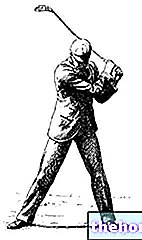Edited by Dr. Nicola Sacchi
Each sport has different technical and athletic characteristics, consequently athletic training must guarantee a specific physical improvement for these characteristics.

Analyzing the motor pattern of the technical gesture in golf, it is evident that to make a good shot with the club it is necessary to express the strength of the whole body through the swing, the basic movement of the game. In fact, this gesture is based on the torsion of the torso, exploiting the expression of explosive force and muscular elasticity in the movement. For this reason, to ensure the maximum performance of the player, it is necessary to acquire the ability to best use all the muscle kinetic chains involved in the torsion by improving:
- muscle elasticity, to widen the movement and thus make it more effective,
- the expression of the explosive force guaranteed by the ability to contract in a strong, fast and synergistic way as many muscles as possible,
- coordination to deliver a correct hit,
- the control of one's body in terms of balance and proprioception to guarantee the precision necessary to execute a perfect shot.
In golf, the development of important muscle masses has no use, therefore its strengthening will not be aimed at the trophism of the muscles but at the increase of the aforementioned muscular capacities, in fact athletic training is distinctly different from the classic work that generally takes place in a fitness center.
Examining the posture and the technical gesture of the golfer during the effort it is evident how the body is stressed in a twisting movement, this means that it must also be trained athletically in this way and that the greatest risk the player faces is certainly an overload. of the back muscles, stressed to a large extent by the torsion itself. In particular, the lumbar muscles, if not well trained, both in terms of strength and elasticity, could lead to annoying pains.
It must also be remembered that striking with a club also causes great tensions in the elbow and shoulder joints, which can also undergo inflammation due to the effort, if not sufficiently trained and strengthened. Therefore, the upper limbs also need to be trained appropriately.
Obviously a strong tree must have good roots, for this reason strengthening the legs is absolutely essential, also because the legs support the individual not only in the game but also in all phases of daily life, so a workout cannot be defined as functional if it does not include a full-bodied strengthening work on the lower limbs.
As repeatedly stressed, the muscular elasticity of the trunk is certainly a fundamental component of the golfer's athletic training, so a good dose of lengthening through stretching or yoga serves to complete the course.
A final note concerns the fact that golf is an asymmetrical sport as the gesture with the club always develops towards the same side, therefore the preparation must compensate for the imbalance of symmetry that is generated between the two sides of the body, therefore to ensure this, each exercise must be performed on both sides of the body in the same way and with the same commitment.
By organizing training according to these considerations, any golfer can considerably improve his or her ability on the course.
To learn more: Tokyo 2020 Olympics, all about the summer games




























